Gustavo Cenci
1897 - 1982
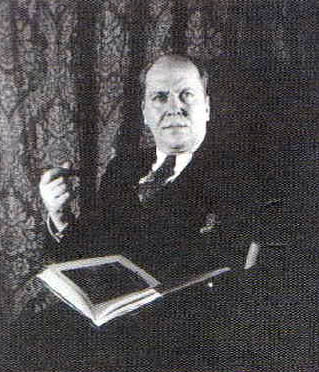 |
Gustavo Othello Cenci was born on January 27, 1897
in Terni, Umbria, Italy. Gus was the youngest surviving child of Agostino
Cenci and Alessandra Formiconi Cenci.
Nothing is known at this time about Gus' life before
immigrating to the United States. Gus, his mother, sister Clelia, and older
brother Elio, sailed as steerage passengers from the Port of Naples, Italy
on June 9, 1905, aboard the S.S. Sicilian Prince, and arrived at Ellis
Island on June 27, 1905. From Ellis Island, the family traveled, most likely
by train, to Trenton, New Jersey, to meet Agostino, and two of Gus' brothers,
Dante and Terzo, who had previously immigrated in 1901 and 1903, respectively.
Upon arriving in Trenton, the family lived at 209 Elmer Street, in the
Chambersburg section of Trenton. This was, and still is, an enclave for
Italian-Americans.
From Trenton City Directories of 1907 and 1909, we
know that Gus' parents, Agostino and Alessandra, were potters, working
in the thriving ceramics and pottery industry that the city housed. Trenton
was the main supplier of ceramics and pottery to the entire country.
|
The Cenci family moved north to New York City in April
1912.
Beginning on October 14, 1913, when Gus was living
at 170 East 108th Street, New York City, through 1920, Gus was a student
at the National Academy of Design. Here he studied various painting techniques,
and garnered several prizes, including the 1918 Hallgarten Prize for Painting
($15), the 1919 Cannon Prize for Painting from the Nude ($100), the Mr.
C.C. Casper Scholarship, the 1919 Hallgarten Prize for Painting Class ($50),
and the 1920 Hallgarten Prize for Painting ($50).
According to the 1915 New York City Directory, Gus
was living with his father "Augustus," a chef, at 1976 Lexington
Avenue. Gus is listed in this directory as "artist."
Because a single sheet of letterhead survives today,
we know that in 1916, Gus and his brother Elio, formed the Cenci Art School,
where fine and commercial arts were taught. It is unknown where the business
was first housed, but the brothers set up shop in Toms River, New Jersey,
sometime in the 1940s.
According to Gus's World War One Draft Registration
Card dated June 5, 1918, Gus was living at 1976 Lexington Avenue, NY, NY,
and was employed by Western Electric, NY, NY. From Gus' citizenship papers
that were filed in 1940, it was learned that Gus was drafted into service
for the United States in World War One. His draft board was number 166
in Manhattan (source: World War One Draft Registration Cards 1917-1918,
NARA, Roll 1786969). He served in the United States Army Infantry from
September 9, 1918 (Serial Number 4883247) and was honorably discharged
on September 14, 1918, having been separated at Camp Gordon, Georgia. Why
Gus had a 5-day Army career is unknown.
According to the 1920 U.S. federal census, Gus, age
23, was living at 308 East 16th Street, and was an artist working at a
school.
| Considered a highlight of Gus's early career was his
affiliation with the renowned American etcher, illustrator and historian,
Bernhardt Wall. Wall first studied at the Buffalo Art Students League before
going to New York to study under Henry Reuterdahl and apprentice in etching
under William Auerbach-Levy. He began his career as a lithographic illustrator
in 1889 and then served with the 202nd NY Volunteers during the Spanish-American
War. From 1902 to 1913 Wall worked mainly as a commercial artist in both
New York and Buffalo. Wall regularly bound and published his own etchings
and occasionally included those of his contemporaries. Gus's etching "The
Fur Cap" is featured in "Wall's Etched Monthly" Number 1,
Volume 3, published September 1921, and reprinted in the 1924 edition.
It is unknown how Gus came to the attention of Bernhardt Wall, but it is
noted that Wall's address in 1921 was 1947 Broadway, New York City.
In the Polk's NYC Directory (Manhattan & Bronx)
Residential Directory of 1925, Gus's entry is as follows:
Cenci, Gustavo (Am Lamp Shade Co) h310 E. 116th. His
brothers Elio and Terzo are also listed as living at this address.
|
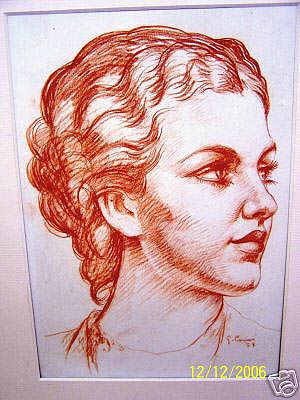
Red Drawing of Woman - 1938
|
According to the February 28, 1928 edition of The Frederick
Post newspaper (Frederick, Maryland), Gus and his brother, sculptor Terzo
Cenci, are pictured working from live model Rev. Lincoln Caswell, on a
painting (Gus) and a sculpted bust (Terzo). The photo caption confirms
that work was done "at New York," and is a news service photo
by Pacific & Atlantic. Caswell was a descendent of President Abraham
Lincoln, and bore an uncanny likeness to his progenitor. He was also a
scion of the Caswells of Caswell & Massey.
The 1930 U.S. federal census shows Gus, age 32, living
at 310 East 116th Street, as a decorator with his own shop.
|
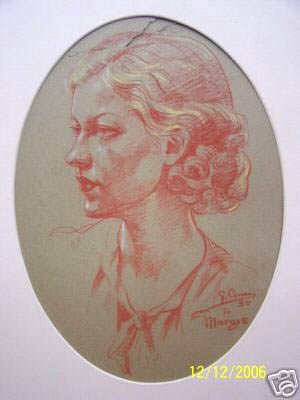
Margie - 1934
|
In 1933, through a mutual friend, a young artist still
in high school was brought to Gus's attention. Her name was Lucia Autorino.
Gus's studio at that time was at the corner of 23rd Street and Lexington
Avenue in New York City. Here at this studio, Gus taught mural painting
to Lucia, who already had a substantial portfolio. Lucia went on to study
at the National Academy of Design. She later married Attilio Salemme, after
the two met when both were working at the Guggenheim. Lucia is one of the
foremost female American abstract artists, and credits her early studies
with Gus for much of her technique.
With the Depression years in full swing, Gus applied
for a Social Security card on December 4, 1936. He was then living at 116
Lexington Avenue, and listed his employer as the Treasury Relief [Art]
Project (TRAP). (Created in 1935 by a Works Progress Administration grant
awarded to the Treasury Department, TRAP was formed to give work to unemployed
artists and to bring as many people as possible into a new and sometimes
daily relationship with art.) Gus and many other artists produced works
for federal buildings and federal hospitals.
|
| During his tenure with TRAP, Gus was apparently a
prolific painter of murals. In 1936, he assisted the noted muralist, Domenico
Mortellito, in the painting of 4 arched panels and 9 lunettes, all oil
on canvas, depicting occupations, and painted in the Depression-Realist
style. These works still can be seen in the Port Chester, New York Post
Office. At the time, a controversy raged over the painting of these murals.
The dispute seems to have been part of a quarrel between local Democratic
and Republican factions, but the stated objection was to its colors which
then seemed loud, but seem tame today. |
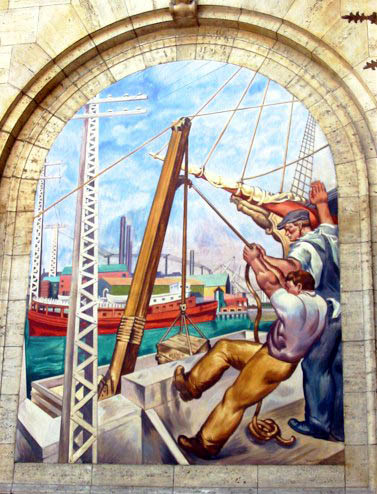
Port Chester, NY Post Office
(image courtesy of the USPS)
|
|
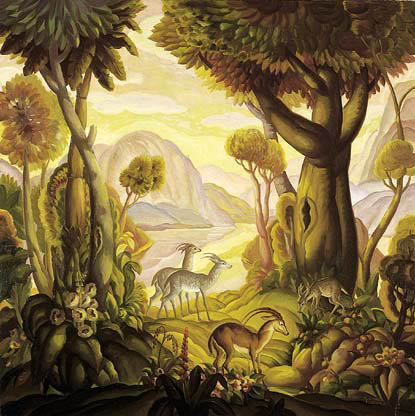
From the Smithsonian Collection
|
Also in 1936, Gus painted another TRAP work which
is untitled. This work recently came to light, and is currently in the
collection of the Smithsonian Museum of American Art in Washington, DC.
The oil on canvas depicts a mountain and forest landscape with deer. This
theme was a favorite of Gus' that he carried on throughout the years.
Additionally during this time, according to Gus' nephew,
Gus painted murals on the walls of some of New York City's movie houses.
Gus filed a Petition for Naturalization on May 24,
1940 in the Southern District of New York. He listed his address as 430
East 148th Street, Bronx, NY, and his occupation as "artist-mural
painter." On August 27, 1941, at the age of 44, Gus swore an Oath
of Allegiance to the United States of America.
|
With the outbreak of World War Two, newly-sworn US
citizen Gustavo Cenci filed a draft registration card. By this time he
was 45 years of age, residing at 432 Lafayette Street, New York City. He
did not serve.
Through an interview with Gus' nephew, it was learned
that Gus at one point in time went back to Europe, to Spain and France,
to study in these countries. Anecdotally, it was related that Gus had been
a student at The Cooper Union in New York City; this has not been confirmed.
According to one of Gus' long-time models, Gus knew his contemporaries,
Pablo Picasso and Marc Chagall.
According to the July 1956 Ocean County telephone book,
Elio and his brother, Gustavo, were both living at 212 Main Street, Toms
River, telephone number TomsRiv8-0969.
According to one of Gus's former models:
"Gus and my mother loved to talk together. He
was a most convivial person, had a lot of friends. My recollection is that
he spoke with a marked Italian accent. I think he was considered somewhat
bohemian (since he was an artist), in a small town like Toms River. He
lived down the street from us. Gus gave the painting I now have to my mother
one Christmas and she later gave it to me. What I do remember is that I
was a terrible sitter: I couldn't sit still, hated posing! He did some
of the painting from memory. My mother passed away in 2001. I remember
she told me that the studio burned down, but I don't remember where it
was or when it happened."
GUS IN SULLIVAN & ORANGE COUNTIES, NEW YORK...THE
LATER YEARS
Sometime in 1963, Gus moved to Monticello, New York,
living at 374 Broadway. He wrote a letter to his old friends from Toms
River, Ben & Sadie Simmons, giving them an update on his life, along
with his new address. By 1966, Gus had moved to Cairo, NY, and rented a
storefront and upstairs apartment on Main Street, a few doors down from
the Post Office. Here he gave art lessons, sold paintings and supplies,
and also sold cameras and other photography equipment. It was in this shop
that Gus befriended Cairo's current town historian, Robert Uzzilia. Gus
and Bob spoke frequently about photography and football.
According to Bob,
"The highlights of our conversations include his
being commissioned to do a large mural in the city of Baltimore as a young
aspiring artist. He also did some nice commission artwork throughout the
Hudson Valley of landscapes. Even one for the grocery store we used to
own on Main Street in the 60s & 70s, but he also did still-lifes and
people. I have a few pieces of his work in my collection. I remember him
looking the part of the artist, complete with beret and smock, often working
in his window. Paintings lined the wall in the little studio (which unfortunately
has been totally remodeled. It was formerly a fish store, I believe in
the 40s & 50s). I don't know how successful he was commercially, but
I thought he was an interesting person to know and I valued his friendship."
When the old A&P grocery store was on Cairo's Main
Street, Gus was commissioned, in 1963, to paint four 3'x6' murals that
hung in the store. Two of these are now in the possession of Robert Uzzilia,
and two are in the possession of Gus' family.
From a letter dated March 17, 1966 from Gus to his
friends Ben & Sadie Simmons of Toms River, it was learned that Gus
was a Third Degree Mason.
| Throughout his lifetime, Gus gave away and sold many
paintings to friends and family members. Unfortunately, a significant number
of these were stolen or destroyed. A full set of kitchen furniture, decoratively
hand-painted by Gus, is in the possession of his grand-niece. Many paintings
are in the possession of various family members living throughout the United
States.
On January 25, 1982, Gus was found dead in his Cairo,
NY, art store/gallery. He was two days shy of his 85th birthday. His remains
were cremated. He never married and had no children. According to Gus'
niece his ashes were scattered, per his wishes. (Rev: 5/28/07)
|
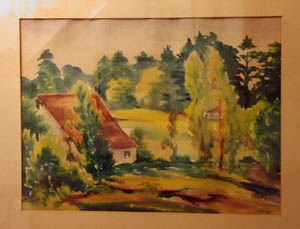 |
- biography and photographs contributed
by Margaret Cenci, great-niece of Gustavo Othello Cenci
Bio Page
New York
Home
E-mail Nancy
© 2007
Nancy Lorance
All Rights Reserved.





